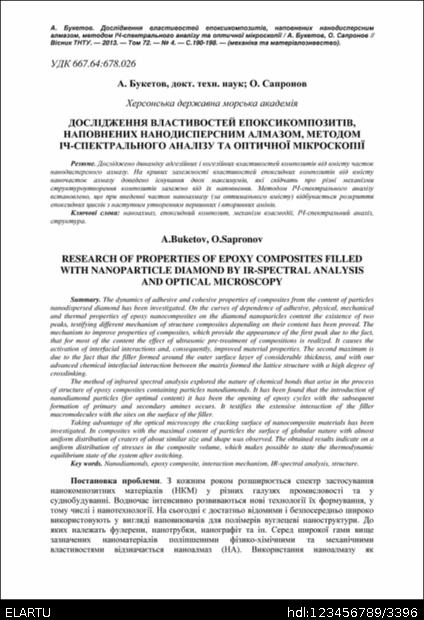Använd denna länk för att citera eller länka till detta dokument:
http://elartu.tntu.edu.ua/handle/123456789/3396

| Titel: | Дослідження властивостей епоксикомпозитів, наповнених нанодисперсним алмазом, методом ІЧ-спектрального аналізу та оптичної мікроскопії |
| Övriga titlar: | Research of properties of epoxy composites filled with nanoparticle diamond by IR-spectral analysis and optical microscopy |
| Författare: | Сапронов, Олександр Олександрович Buketov, A. Sapronov, O. |
| Bibliographic description (Ukraine): | Букетов А. Дослідження властивостей епоксикомпозитів, наповнених нанодисперсним алмазом, методом ІЧ-спектрального аналізу та оптичної мікроскопії / А. Букетов, О. Сапронов // Вісник ТНТУ — Тернопіль : ТНТУ, 2013. — Том 72. — № 4. — С 190-198. — (механіка та матеріалознавство). Buketov A. Research of properties of epoxy composites filled with nanoparticle diamond by IR-spectral analysis and optical microscopy / A. Buketov, O. Sapronov // Bulletin of TNTU — Ternopil : TNTU, 2013. — Volume 72. — No 4. — P 190-198. — (mechanics and materials science). |
| Utgivningsdatum: | 19-nov-2013 |
| Date of entry: | 3-sep-2014 |
| Utgivare: | Тернопiльський національний технiчний унiверситет iменi Iвана Пулюя |
| Place of the edition/event: | Тернопіль |
| UDC: | 667.64 678.026 |
| Nyckelord: | наноалмаз епоксидний композит механізм взаємодії ІЧ-спектральний аналіз структура nanodiamonds epoxy composite interaction mechanism IR-spectral analysis structure |
| Sammanfattning: | Досліджено динаміку адгезійних і когезійних властивостей композитів від вмісту часток
нанодисперсного алмазу. На кривих залежності властивостей епоксидних композитів від вмісту
наночасток алмазу доведено існування двох максимумів, які свідчать про різні механізми
структуроутворення композитів залежно від їх наповнення. Методом ІЧ-спектрального аналізу
встановлено, що при введенні часток наноалмазу (за оптимального вмісту) відбувається розкриття
епоксидних циклів з наступним утворенням первинних і вторинних амінів. The dynamics of adhesive and cohesive properties of composites from the content of particles nanodispersed diamond has been investigated. On the curves of dependence of adhesive, physical, mechanical and thermal properties of epoxy nanocomposites on the diamond nanoparticles content the existence of two peaks, testifying different mechanism of structure composites depending on their content has been proved. The mechanism to improve properties of composites, which provide the appearance of the first peak due to the fact, that for most of the content the effect of ultrasonic pre-treatment of compositions is realized. It causes the activation of interfacial interactions and, consequently, improved material properties. The second maximum is due to the fact that the filler formed around the outer surface layer of considerable thickness, and with our advanced chemical interfacial interaction between the matrix formed the lattice structure with a high degree of crosslinking. The method of infrared spectral analysis explored the nature of chemical bonds that arise in the process of structure of epoxy composites containing particles nanodiamonds. It has been found that the introduction of nanodiamond particles (for optimal content) it has been the opening of epoxy cycles with the subsequent formation of primary and secondary amines occurs. It testifies the extensive interaction of the filler macromolecules with the sites on the surface of the filler. Taking advantage of the optical microscopy the cracking surface of nanocomposite materials has been investigated. In composites with the maximal content of particles the surface of globular nature with almost uniform distribution of craters of about similar size and shape was observed. The obtained results indicate on a uniform distribution of stresses in the composite volume, which makes possible to state the thermodynamic equilibrium state of the system after switching. |
| URI: | http://elartu.tntu.edu.ua/handle/123456789/3396 |
| ISSN: | 1727-7108 |
| Copyright owner: | © „Вісник Тернопільського національного технічного університету“ |
| Content type: | Article |
| Samling: | Вісник ТНТУ, 2013, № 4 (72) |
Fulltext och övriga filer i denna post:
| Fil | Beskrivning | Storlek | Format | |
|---|---|---|---|---|
| TNTUB_2013v72n4_A_Buketov-Research_of_properties_190-198.pdf | 432,85 kB | Adobe PDF | Visa/Öppna | |
| TNTUB_2013v72n4_A_Buketov-Research_of_properties_190-198.djvu | 264,15 kB | DjVu | Visa/Öppna | |
| TNTUB_2013v72n4_A_Buketov-Research_of_properties_190-198__COVER.png | 191,63 kB | image/png | Visa/Öppna |
Materialet i DSpace är upphovsrättsligt skyddat och får ej användas i kommersiellt syfte!